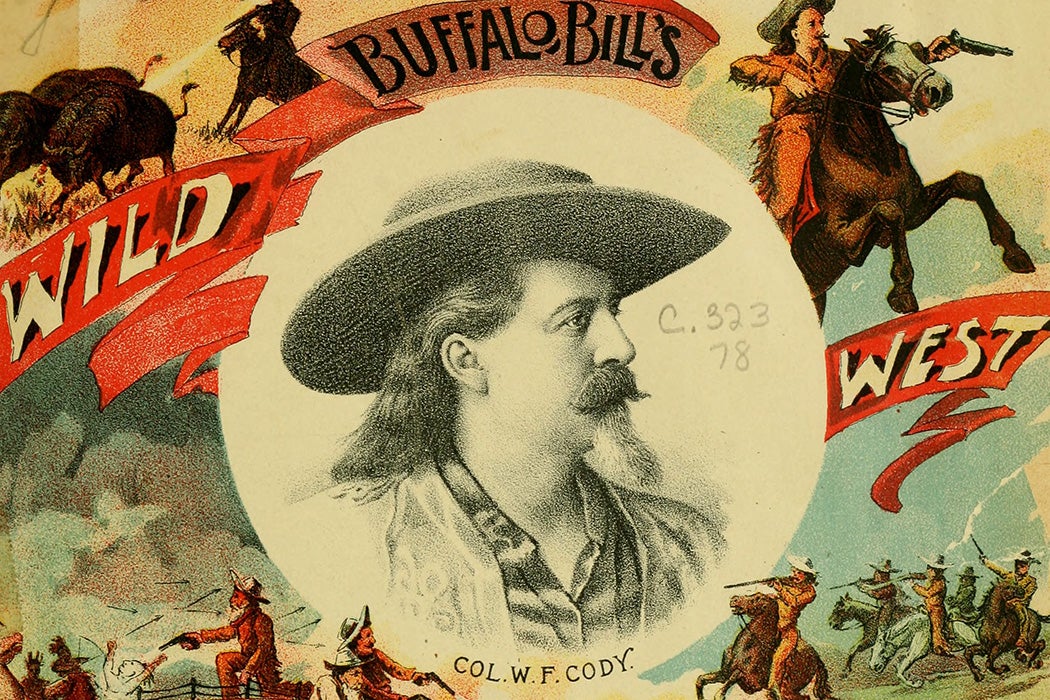Winifred Johnston, writing in 1935, lamented the passing of Wild West entertainment with the closing of the Miller Brothers’ 101 Ranch Real Wild West show a few years earlier, on a painfully hot summer day in Washington, DC. For the last time, she sighed, “the Deadwood Coach set out on its perilous trip across the plains…outriders fell from startled mounts, Indians swooped down upon the swaying, battered coach, and cowboys dashed wildly to the historic rescue.”
From the early 1880s to the 1930s, hundreds of Wild West shows of the sort Johnston describes provided don’t-miss entertainment for millions of Americans. Performances lasted two to four hours and catered to a shifting attention span with a long list of component acts. Typically, a show might involve live demonstrations of horsemanship and rodeo skills, trick shooting, frontier animals both wild and domestic, and dramatic re-enactments of frontier history. For the most part, acts emphasized action, raising up the heroism of cowboys and settlers in an era of American expansion. Most often associated with “Buffalo” Bill Cody, Wild West shows became wildly popular and both built and spread the mythos of the American frontier West. (They weren’t only popular in the States; in the 1880s, Cody took his vaunted show overseas, delighting Queen Victoria and engaging in a tour of the Continent.)
Wild West shows had a lot in common with the tented circus, also in its golden-age height at the time, depending on excitement, grandiosity, and the employment of hundreds of people to put on a spectacle of ethnographic curiosity and superlative skill. The shows paraded through town to whip up excitement, the thread of horses, “rough riders,” and Plains tribes in full regalia in marked contrast to everyday life on Main Street. A certain celebrity was part of the appeal, too. In addition to headline promoters like Cody and Pawnee Bill, audiences throughout the heyday of Western entertainment might have seen performances by Annie Oakley, Calamity Jane, and Will Rogers, to name a few.
The branding and visual presentation of the shows were top-notch. It was an immersive experience as folks sat on bleachers, eating peanuts as horses thundered past and gunfire rang through the air. For many folks, this excitement lent an air of authenticity to the event. One of the most distinctive—and problematic—aspects of the shows came when, much like the circus, they went beyond simply presenting a variety bill and embraced spectacular, large-scale re-enactments of US history that reinforced ideas of imperialism and white supremacy. The cast was literally performing American nationalism, writ large in the sort of stereotype that read well even from the cheap seats.
Re-enactments came in many triumphalist flavors. The Congress of Rough Riders rode in parade pageantry; brave cowboys defended home and sovereignty; a thundering corps acted out “Custer’s Last Fight;” and in souvenir photos, Cody and Sitting Bull stood together clutching the same rifle. Moreover, this appeal to shared vision also came with an assurance that the performance was both authentic and educational. As Alison Fields writes of the Miller Brothers’ show,
The battle scenes gave spectators the sense that they were experiencing these conflicts firsthand through a lens that highlighted the heroism of the cowboys and soldiers and the savagery of the Indians. […] The participation of recently subdued Indian leaders in the roles of defeated enemies added to the immediacy of the experience. For many years, audiences were drawn to Wild West shows to see real cowboys and Indians, to witness historical agents in a manner that preserved the adventure of battle but none of the risk.
The acts relied on making an exotic “other” of all manner of foreign cowboys, from Cossack riders to Mexican vaqueros, but the narrative of conquest and the mythmaking of the Wild West turned specifically on Native performers. The showtime story may have centered on the bravery of cowboys and settlers, but Linda Scarangella McNenly writes that, in the eyes of the crowd, “the stars of the show were the ‘Indians,’ who drew in the crowds in the hundreds of thousands.”

Native performers participated in these shows willingly, but not without reason or awareness. Fields writes that performance
provided attractive opportunities for Native people to travel, earn a living, and engage with a broad variety of people. For some performers involved in the earlier Indian Wars, participating in a Wild West show actually shielded them from government persecution or imprisonment.
In 1902, Luther Standing Bear joined Buffalo Bill’s show for an international tour. As Ryan E. Burt writes, changing federal policy had made it difficult for Standing Bear, “as with many Lakota, to support his family at Pine Ridge reservation…Cody’s show promised gainful employment, mobility, and perhaps a sense of adventure.”
Weekly Newsletter
Performing for King Edward VII, Standing Bear was asked to dance, which he did with “fancy steps” and “a few Sioux yells” to cater to stereotype. This was highly calculated, argues Burt, evidence that Standing Bear clearly understood what Native scholar Philip Deloria calls the audience’s “Indian expectations.”
These expectations implicated social and political power dynamics, reinforced ideas that Native populations were both primitive and rapidly vanishing, and assuaged any audience guilt by touting a “foe-to-friend” narrative. Beyond the formal performance, sideshows and mock “Indian villages” allowed white audiences to view Native American culture as a curiosity and an ingredient in the mythmaking at which Cody and his fellow promoters were so skilled.
Wild West shows afforded Native American performers a good living and a degree of celebrity at a time when neither was readily available to them, but the shows also asked them to re-enact their own conquest on a daily basis. The Buffalo Bill Center of the West points out that while Cody supported his performers with fair pay as well as cultural and political advocacy, he profited handsomely from lodging a different myth in the public imagination: Native people as “the last impediment to civilization,” who “had to re-fight a losing war nightly.”







